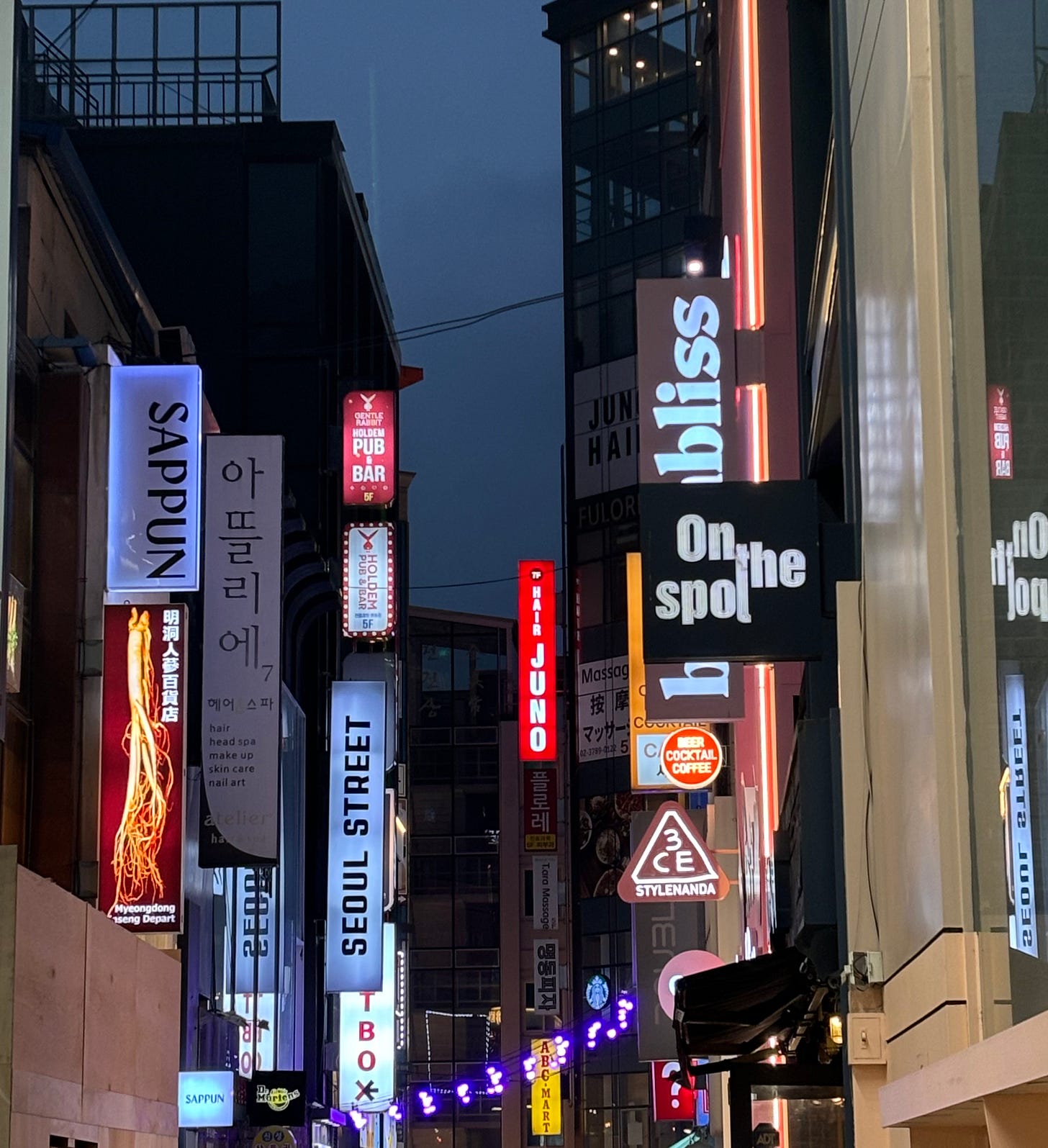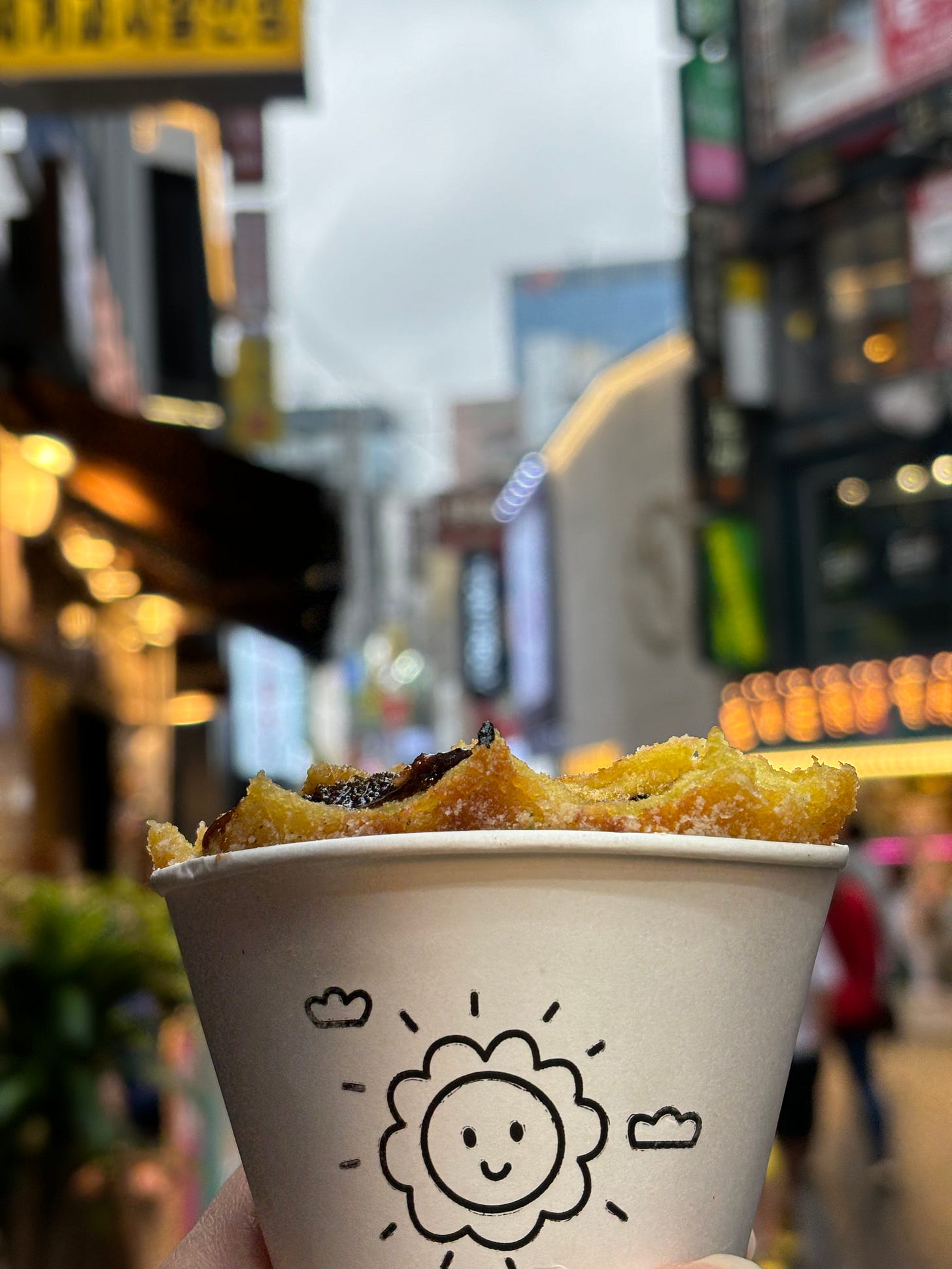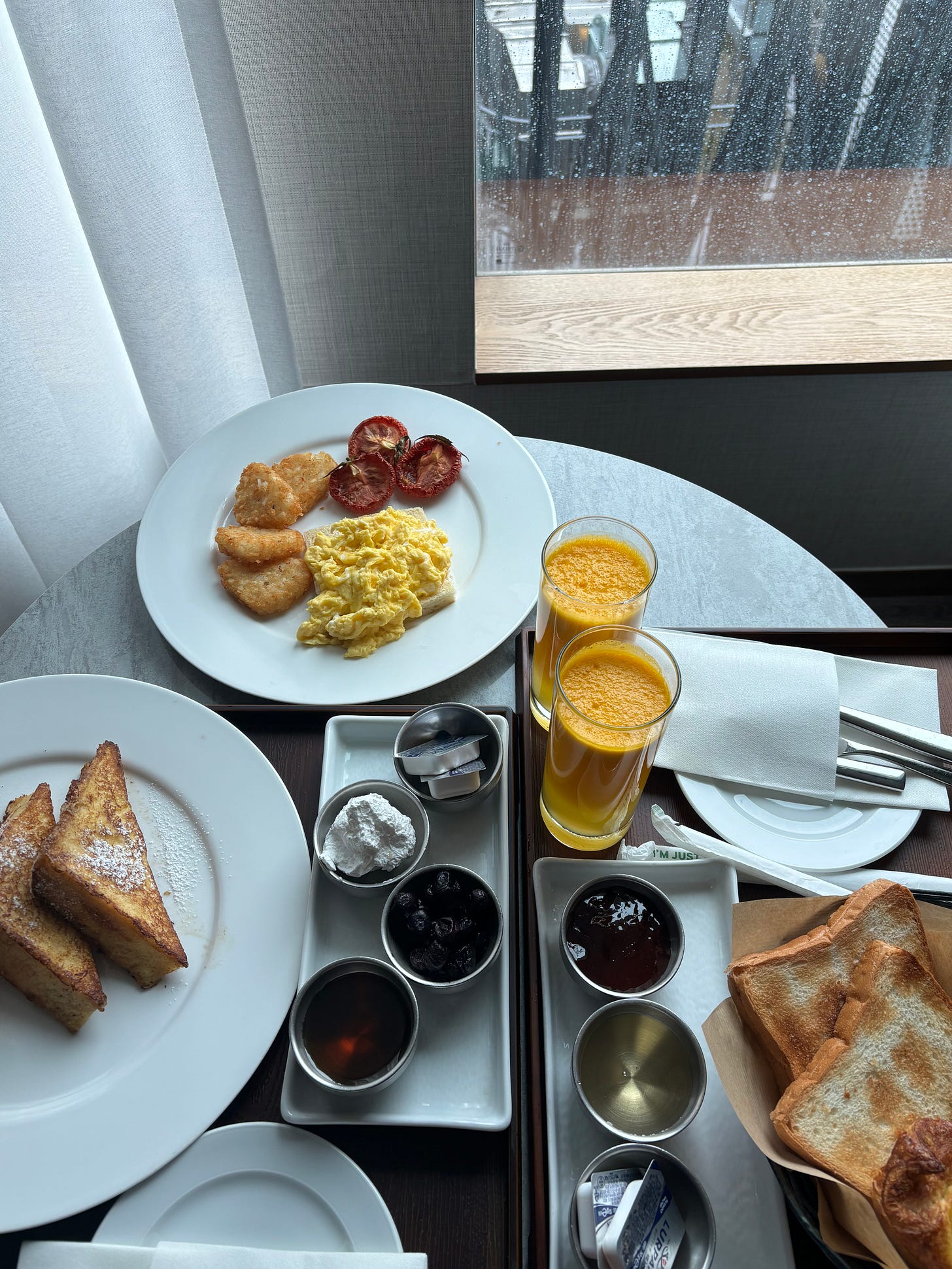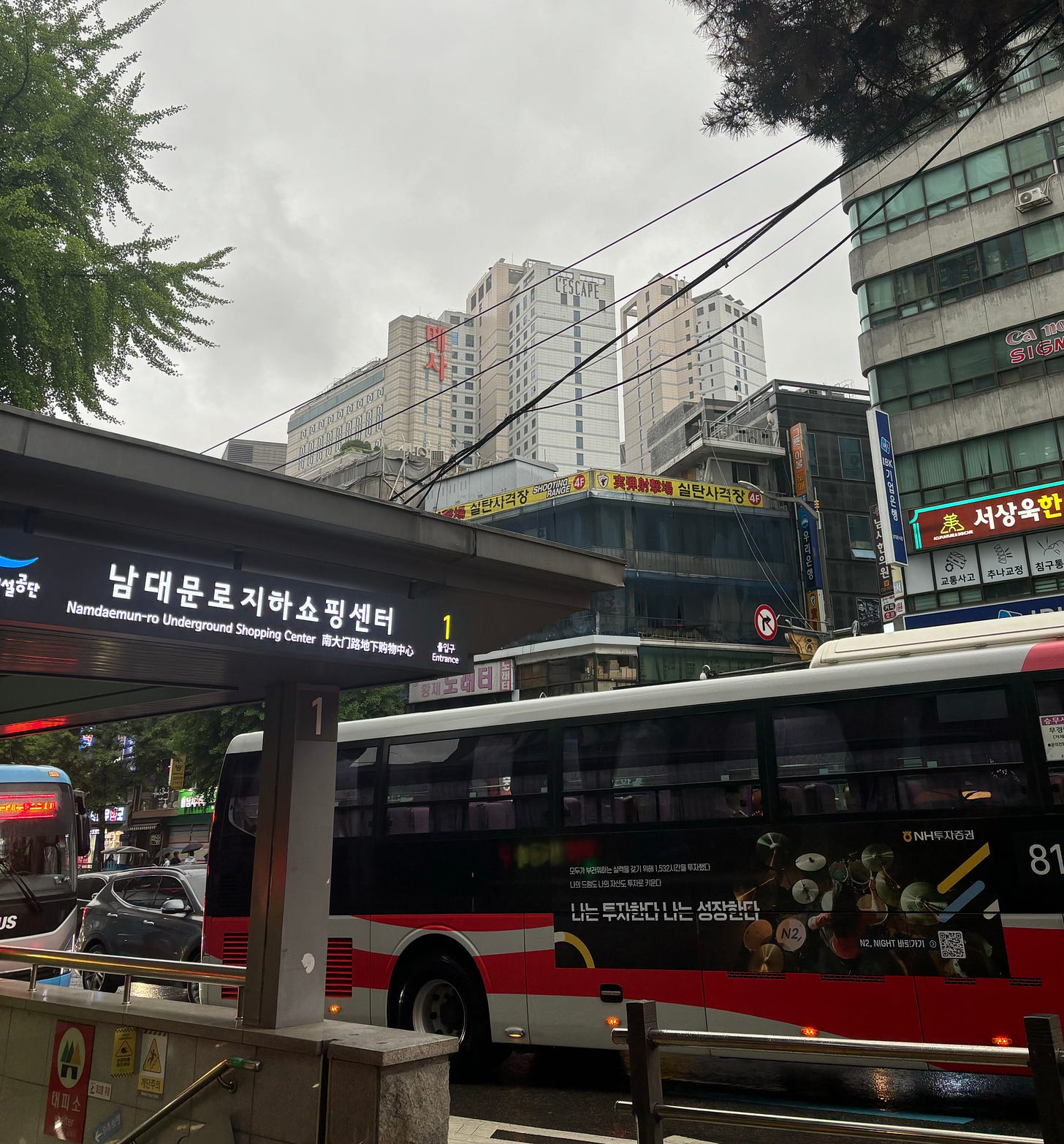10 Travel Tips.
Annyeonghaseyo
I’m not really into the “3 great ideas for….” or “5 things you need to do before….” or any of those click-bait, overly simplistic list messages; but, in honor of the upcoming 1 year anniversary of our trip to Seoul, South Korea, I’m allowing myself some nostalgia and sharing a few lessons-learned.
The trip was multi-layered for us, and I’m not going to explore those personal details in this newsletter, but I will say that it was powerful and meaningful and important for us. In many ways it feels like a life-time ago. Multiple times throughout this past year, we’ve said to each other, “I can’t believe we were in Korea only 3 or 5 or 8 months ago.”
It’s the first international trip I’ve ever taken (I’m over 60 years old, to put that in perspective.) My 3 central goals – encourage, educate, empower - were well-met before, during, and after the trip.
I want to go back! I don’t see that happening any time in the near future (though, I try to never say never), so for now I’ll travel it in my memories as I share some tips and reflections with you.
1. Research
Be sure to take care of the essential, practical details.
· We registered our trip with the consulate. We notified our bank/credit cards of our travel dates so we didn’t have fraud holds placed on accounts while traveling.
· We added local apps to our phones (ex. Google maps is not supported there.) We added a variety of apps: maps, language, ride-shared, transportation services.
· We purchased adapters for all of our electronics.
· We brought extra chargers for everything.
· We made copies of all important papers (licenses, passports, charge cards, insurance cards, emergency numbers, etc.)
· We packed pain and stomach distress meds, bug spray, suntan lotion (all of which we could have bought there, but it was good to have our preferred brands.)
· We exchanged some cash for Korean currency (Won) before we traveled.
So, the money exchange has a funny story.
On nearly our last day, we wanted to go back to the street vendors – who only take cash – and realized we were out of Won (turns out, we weren’t. I had more in a different bag which I ended up having to spend at the airport before our flight home, but that’s not the point of this story.)
Anyway, we were very upset and started looking for cash exchange services nearby, but every one we went to said that they could only exchange a $100 dollar bill. Which we did not have. So, we sat and tried to brainstorm how to get a $100 bill and were looking online to see where there was an ATM that we could use that would let us select to receive a $100 bill instead of 20s…and then realized…DUH!...the ATMs would distribute the cash in LOCAL currency! We could use our U.S. card at the ATM to get Won. We didn’t need to use a street-side currency exchange service (In our defense, we were exhausted!).
That “aha” was one funny-in-hindsight lesson-learned. The other was to relax, take a breath, and trust that most things have a solution and we’re capable of figuring things out.
Go beyond travel guide information.
Use social media to learn from locals. Just as we have influencers in the U.S. who share and promote all the best, most popular spots and things to do, so do most places you’d travel to. Go to their sites. Follow the chain from one of their sites to others. The algorithms will do the rest for you. Before you know it, your feed will be filled with cool ideas for your travels.
We created a shared folder and every time one of us would see something interesting, we’d add it to the folder. Not only did it give us great ideas (including practical ones – like the need for country-specific apps), it ramped up our mutual anticipation for the trip.
Planning and imagining through social media became a fun and valuable part of the experience.
2. Plan your itinerary and plan to adjust it.
I’m a planner. I figured out our days and times and planned multiple stops within specific sections of the city. Mostly, that worked out great! But, some locations were farther than we’d thought, or the ways to get there were less convenient than we’d anticipated, or we wanted to spend more time in one area than I’d allotted, or we didn’t feel well, or we were simply tired or not in the mood for a particular outing on a given day. So, we skipped some things. Some were priorities, so we found ways to rearrange on other days so we could visit; but, some, we just let go.
You can’t control the weather, so it’s likely you’ll need to adapt for it. It rained on multiple days – sometimes on days when no rain was predicted so we’d left our recently purchased umbrellas in the room. We ended up buying 3 umbrellas during our week! The weather was one of the things that led to shifts or deletions in our itinerary. But, it ended up being a wonderful unexpected pleasure on our trip. The neon lights from the markets and the cars and busses reflected in the wet streets was magical!
In addition to having staff inside who repeatedly dried the rain-slicked marble floors, most stores and restaurants had umbrella drying stations - some electric blowing ones and some simpler fabric-lined ones - outside their doors. And, people (including us) just left their umbrellas in stands under the overhangs or just inside the doors. We had initial thoughts of “What?! People just leave their umbrellas here. Anyone could take them. How do you know yours will be here when you leave?” But, ours always was. And, pretty quickly, we just stopped thinking about it and were grateful for the relaxed and practical norm that meant we didn’t have to carry our wet umbrella around inside.
And be open to doing things you hadn’t planned. Visiting a Hanok Village was only a tentative on our list. We thought we’d probably skip it. But, partly because we had to adjust other stops and days, we were near one on a lovely afternoon, so decided to walk over. It ended up being one of the best days of our trip. It was a better day to visit a palace than the one we’d scheduled – so that was fantastic and we got some of our favorite pictures there. And, then the unplanned day in the Hanok Village was gorgeous and educational and yummy!
3. Budget your resources.
By this, I mean your personal resources, not your financial ones. Refer back to an earlier newsletter and be realistic about allostatic load.
Traveling is a lot! Traveling to another country is more! Traveling to a country where you don’t speak the language is even more! You are placing lots of extra demands on your physical, cognitive, and emotional resources.
Take care of yourself. Go to bed at a decent time. Drink lots of water (get a filter or buy bottled water if you think the differences in the water might bother your stomach.)
Splurge on easier transportation options sometimes if you’re exhausted or hurting (ouch, my feet, my back, my hip!)
Allow yourself some comfort food. You don’t have to stretch out of your comfort zone to experience a new cuisine at every meal. On a few days, when we had maxed ourselves out and figuring out where to eat was just one thing too much, we had burgers (vegetarian) and fries in the hotel restaurant for dinner. On a rainy morning, we ordered French toast and eggs from room service instead of heading out first thing.
We explored and adventured and experienced plenty. But, being realistic about some needs for rest and familiarity let us enjoy those novel experiences more fully.
4. Mindfully enjoy being surprised.
Trust culture: The umbrella stands outside were not an anomaly. It’s part of the collectivistic, trusting culture to leave valuables unattended everywhere! In restaurants, people routinely left their laptops and purses on the table when they left to go to the bathroom or back to the counter or to a shop in another part of the store. At the airport, people left their suitcases in open sectioned-off areas outside restaurants. We did too, though we watched them through the restaurant window and continued to marvel that this practice was accepted. (We never did leave our purses/backpacks unattended at restaurants in the city – that was one step too far out of our comfort zones.)
Other unexpected little surprises:
Style: It’s a monochrome culture. Architecture was mostly simple, and buildings were grey or white. The pops of color were in the neon signs and the traditional vibrant colors in tile work, paper lanterns, and in the abundant flowers. People of all ages usually were dressed conservatively (think U.S. 1950s) and in whites, blacks, greys, and navy blues – with occasional pastel accents. The huge multi-floor department stores carried hundreds of designer options, but almost all of those were in the solid and neutral colors we saw on everyone.
The retail workers dressed up. Minimum wage workers wore suit jackets and skirts and conservative shoes.
The monochrome palette – which we first noticed in crowds and then couldn’t stop noticing – was emphasized by the exceptions to the rule: Elders in colorful mismatched patterns, youth in micro-mini skirts and k-pop extreme hair colors and accessories.
City life: There were crowds! It’s a vibrant city of contrasts: fashionable, expensive, ultra-modern shops across the street from crowded, noisy, traditional markets. People walking everywhere! So many people! The main roads were huge and the crosswalks were massive. Everybody waited politely in clearly marked areas – many with lighted bars on the ground in lieu of walk/don’t walk signs – and then overtook the streets en masse as traffic in all directions stopped.
Busses were ultra-clean and on-time. Everybody sat – in raised, plush seats with antimacassars on each headrest and curtains on the windows. People waited in polite lines to get on. No rushing or shoving.
People smoke. Actually, mostly men. And there are designated areas to do so throughout the city. Smoking men gathered in packs in glass-enclosed spaces near intersections and outside office buildings and stores.
Food: As a vegetarian and a person who doesn’t love super-spicy food, I expected to have trouble finding food I’d like. And, there were some challenges in terms of meals. But, it’s perfectly OK to survive for a week on lots of treats, right? And, I discovered that Korea has some of the best chocolates and creams I’ve ever tasted! I had no idea. Is it something they’re known for that I’d simply missed in my pre-trip research? I don’t know, but what a wonderful, indulgent surprise.
Street food was another terrific surprise. Visiting the markets in the evening to fully experience the street food action was on our list, and I again expected (somewhat correctly) that much of it wouldn’t be to my taste, but….what was to my taste – including some things I was a little nervous about trying – were back-for-seconds incredible! And, it was just plain fun.
5. Mix tourist stuff with your personal interests and local’s hangouts.
We did the mandatory tourist stuff: Gyeongbokgung Palace (next time we’ll rent hanboks!) was gorgeous and fascinating. The temple we visited was smack in the middle of a commercial district and surprisingly ordinary and super-touristy. The Seoul Tower and the mountains in the distance were perfect photo backdrops.
But, we used our pre-trip social media research to identify some local shops and sites and restaurants to visit.
And, we intentionally built in time to enjoy our unique interests through a new cultural lens.
We kayak, so, we scheduled time to kayak on the Han River. It was further away than we thought; the day was hot, muggy, and grey, and we had some tired, cranky moments, but it was cool; we felt proud and adventurous, and we met a fun and helpful local who got us over our hesitation at taking local ubers…which we used often during the remainder of our trip.
One of us crochets, so we went to a pretty far from the tourist hot spots area of the city to visit a fantastic yarn shop. It was big and bright and colorful, and stopping there led us to explore other unplanned areas that turned out to be other favorites of the trip.
While there, we indulged in a visit to Koriko Café – an absolutely adorable Studio Ghibli’s Kiki’s Delivery Service-themed café that took us on a nostalgic trip down childhood-memories lane, even down to the background music that transported us to simpler (in some ways), lovely times.
6. Things you expect to be hard might not be.
We were pretty stressed about the language barrier. We’d each been using Duolingo for quite a while before the trip, but felt totally unprepared. And, in fact, except for a few key phrases, our Duolingo training was honestly pretty useless. People speak fast in their native language. But, it turned out to truly be no big deal. We’re more fortunate than we deserve that many people around the world speak English – especially the youth. So, often, the simple exchanges we had were in English.
We had learned to read Hangul – a big source of pride for me; but, just because I could sound out the word, didn’t mean I knew what that word meant! I could read the Korean word, but I often couldn’t translate it into English.
And, in the situations when we couldn’t communicate in English or read in English, technology came to the rescue. Google Translate worked. Sometimes we’d just type what we wanted to say, select the translate option, and then held our phone out for the resident to read. A quick aha, and they were always able to help us.
Again, prepare but trust that you’ll be able to figure things out.
7. Be patient.
We planned – generously we thought – for an hour to get through customs. It ended up being more than a 2 hour wait and the a/c wasn’t working properly so it was hot. And we were exhausted after 18+ hours of travel. But, it gave us our first glimpse of the collectivistic culture. People didn’t crowd in the lines. They didn’t complain (though we did hear people commenting that it was the longest they’d ever waited in that line). Nobody was obnoxious. Even the kiddos were pretty chill.
The attitude was clearly “It is what it is” and people were just calm and patient.
And, that set the stage for every other time during the trip when things were crowded or took longer than expected.
Even the waits were IN KOREA! How cool was that?! So, they were just part of the experience we were lucky enough to be having, not something we had to impatiently get through.
8. Communicate.
Communicate regularly, honestly, and kindly with your traveling companions – before and during the trip.
Try not to stress too much about being stressed. You will be stressed. But, be patient with yourself and with your equally stressed-out travel companions.
Know that you’ll probably have different preferences – of places to visit, needs for activity vs. rest, food favorites, openness to risk and adventures, needs for togetherness or alone time, etc.
Talk and actively listen. Compromise. Take turns. Set clear boundaries when necessary (for example, my regular need for pit stops!)
Don’t let frustrations, exhaustion, or resentments build up. Take a breath and take some time to communicate so the experience is special for everyone.
9. Build in time to rest, relax, reflect, and recharge.
After our cranky kayak day – which followed multiple hours-long shopping days – I insisted we build in time to chill. My best times so far on the trip had been ones when we relaxed outside in beautiful spaces or enjoyed some of the best chocolate and creams in cute little cafes – while watching the tourists and the locals go by. I wanted those to be an intentional part of each day – not just a necessary collapse after we’d passed the point of exhaustion. So, I communicated those wants and needs, and the latter part of the week, we always looked for a lovely place to sit and snack and chat and regroup.
Not only were those some of our most treasured times, they made it possible for us to savor everything else more.
Better to miss some planned experiences than to run yourself ragged and be unable to appreciate or fully enjoy some of the best times.
Treasure the gift of relaxing in a new place! Many people never have that opportunity. Savor it.
10. Just go!
Seriously, if you can make it happen (financially and logistically), just go! There were highs and lows, but even the lows were important or valuable (lessons) and layered with the wondrous realization that we were in Korea!
Following travel sites or watching shows is simply not the same as being there. Immerse yourself in another culture. A week is definitely not enough, but, it’s infinitely more impactful, empowering, educational, and just plain fun than anything you could discover through reading or watching.
If you can, I strongly encourage you to just go. I want to go back!
Annyeonghaseyo.
~
Eileen
If you like my content and want to support me on this journey, there are a few easy things you can do:
· Heart my posts.
· Leave comments.
· Follow me on Substack.
· Subscribe to the newsletter (always free).
Emotionally: All of those actions provide me with feedback and encouragement to keep writing.
Practically: The more people take those actions, the more Substack algorithms amplify my work, the more readers will find me, and the more potential agents and publishers will see that there’s a potential audience for my book.
I humbly and fully appreciate your support!









